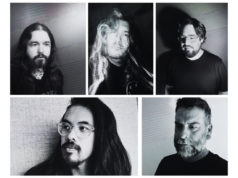Take the elevator down to the 4th Street basement where the Scat Jazz Lounge lives these days, and you’ll find the night-blooming flower of jazz thriving under the dim lights.
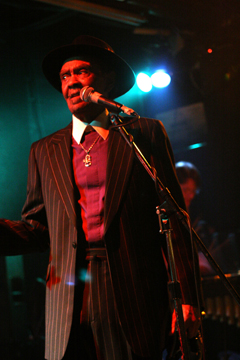 In the immaculate, sparsely apportioned surroundings, amid a sharply dressed, professional crowd, the feeling is one of having left Fort Worth altogether. A generation ago, similarly inclined folks would have gathered about a block to the north, where in the 1980s the Caravan of Dreams nightclub made a space to welcome home a native son who’d had to leave the state to find fame as a jazz musician. Just outside the growing boundaries of downtown is the piano from which a single local jazzbo has kept his chosen musical genre on life support in this town for many years. And only a couple of blocks east of the Scat is the air-toned studio where a talented Louisiana émigré is turning big-band jazz into big business.
In the immaculate, sparsely apportioned surroundings, amid a sharply dressed, professional crowd, the feeling is one of having left Fort Worth altogether. A generation ago, similarly inclined folks would have gathered about a block to the north, where in the 1980s the Caravan of Dreams nightclub made a space to welcome home a native son who’d had to leave the state to find fame as a jazz musician. Just outside the growing boundaries of downtown is the piano from which a single local jazzbo has kept his chosen musical genre on life support in this town for many years. And only a couple of blocks east of the Scat is the air-toned studio where a talented Louisiana émigré is turning big-band jazz into big business.
Soon, jazz aficionados will shut off their record players and take notice. Chamber of commerce types like to talk about some projects being incubators, giving new businesses a protected space in which to grow. So think about downtown Fort Worth as a jazz incubator – not the local birthplace of the genre, but the place where time and again over the years, musicians have come to weather a storm, to unleash a brash new saxophone solo, to introduce a new generation to a yet another version of that most American of musical art forms. On the other hand, jazz in this town was born on the South Side, in the black clubs and schools that sent a long list of greats out to the wider world.
Those who assume that the Fort Worth musical scene only recently diversified from country & western would be wrong by about 80 years. Outsiders (and many locals) figure that jazz (and hockey and avant-garde visual art, for that matter) all fell off a Dallas-bound delivery truck last week, but they’re wrong on all counts. Jazz has been filling the smoky corners of Cowtown’s most eclectic bars for a long time, and it may now be coming into a mainstream spotlight here that’s its seldom known before. The winds of change are blowing outsiders into the Fort Worth jazz world, and the newcomers – along with longtime locals – plan on redefining the very quilting on the fabric of the Tarrant scene. In places like Lola’s, just off West Seventh Street, and over east at the University of Texas at Arlington {where Adonis Rose, summoned to town by the winds of tragedy, is at work}, jazz is spreading its worldly wings again. Not that it’s a smooth flight, of course. Wouldn’t be jazz if it were. Marjorie Crenshaw is more than a little miffed. “Adonis has been overblown,” the longtime jazz educator and local jazz stalwart complained. “We don’t need someone to come from New Orleans and tell us anything. What’s he going to teach Fort Worth about jazz? I’ve lived here all my life.”
Crenshaw, sprightly despite her eight decades, knows the highs and unprofitable lows of the jazz world in Fort Worth. In the 1930’s and 1940’s, a band of sonic rogues was passing through her alma mater, the South Side’s I.M. Terrell High School, also known as Fort Worth Colored High. Future legends like Dewey Redman, Ornette Coleman, Ronald Shannon Jackson, and Dr. John Carter were assembling the building blocks which would eventually permit them to change the very structures defining jazz. Teacher G.A. Baxter encouraged students to push the boundaries of sound. Jazz then was confined mostly to the South side clubs of black neighborhoods. (Crenshaw’s parents let her listen from the back door, where the lively dancing and be-bop wouldn’t tarnish her innocence.) Big bands and talented horn players came from all over to perform in places with names like Zanzibar, China Doll, the Aristocrat Inn, and the After Five Supper Club. Jazz was in its heyday, and musicians like Coleman and Jackson learned a lot from the acts they witnessed on Rosedale Street.
The Southside movement lasted for several decades, drawing white fans and a few brave white musicians. Undeterred by certain policemen’s racist mistrust, musicians like Duane Durrett would leave the clubs when the cops showed up and return when the coast was clear. “In the late 60’s and early 70’s, it was a wonderful vibe,” drummer and Weatherford College music instructor Durrett recalled. Sunday jams happened at the Evans Avenue Flamingo Club. Playing with all sorts, notably saxophone greats James Clay and Marchel Ivery, Durrett earned enough to pay his way through the University of North Texas. “It was all about the music,” he said. “Nobody cared what you were or who you were, as long as you were about the music.” But just when the music settles into a mood, everything changes, because jazz is an ongoing conversation among its players. Composers invented jazz standards more than half a century ago, and every generation since has interpreted that history by its own musical experiences, keeping jazz alive while the world changed around it.
In Fort Worth, the trends started shifting around 1973. Venues began to close, relegating jazz to temporary clubs and to restaurants like Daddio’s, which morphed into the longstanding tradition of the Jazz Café on Montgomery Street, where a lazy yet inspired kind of jazz still rules the brunch crowd. “A lot of musicians got dispirited,” Crenshaw remembered. “No one recognized their genius” – no one in Fort Worth, anyway, so one by one, they started leaving. Many eventually settled in New York, where they carried on the Cowtown jazz tradition far from home. “It is no accident that the jazz world has been influenced over and over and over by musicians from Fort Worth,” says Jackson via a video streaming from his web site. In New York in the early 1970s, Jackson collaborated with Coleman in the harmolodic style of composition. Coleman, who in 2007 was awarded a Pulitzer Prize for music and a Grammy Lifetime Achievement Award, revolutionized jazz with his rhythmically indecipherable phrasings. Judging by his invitation to last year’s Bonnaroo music festival, music fans of all types have come to appreciate his unique contribution to musical history, even if it took half a lifetime for hometown listeners to get a clue.
Back in Cowtown, the jazz fires were banked and burning low but were never allowed to flicker out. The music stayed alive in short-lived clubs, restaurants, and recital halls, with just enough going on to let a handful of players earn the price of next week’s groceries. For decades, they played for pittances, kept going by the integrity of the music rather than by any hope of financial reward. Crenshaw stayed in Fort Worth with her husband, Willie, also a jazz musician. She taught music in public schools for most of her adult life, and played a major role in keeping the Fort Worth jazz torch lit in its darker days. Educating youngsters about jazz traditions kept the art alive when it fell off the mainstream radar. And she worked with the Fort Worth Jazz Society, which she said “saved jazz here” by collecting money for performances and scholarships. But eventually, Crenshaw began to grow dispirited, too, believing musicians would have an exceptionally hard time earning a living playing jazz in this town. Just about that time, though, a new venue flickered into life. Actually, it didn’t flicker, it flamed into being on Houston Street, fueled by, of all things, the money and passion of one of the richest men in town.
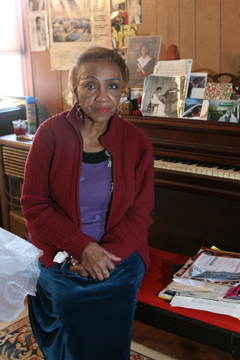 Ed Bass had been messing around as an aspiring actor in New Mexico when he met up with what Cowtown (and a lot of others around the world) would regard as a strange group of friends. They had a theater troupe and ecological theories and wanted to build a spaceship that would take Earth’s survivors to Mars, among other far-flung (and Bass-funded) projects. But they also were jazz-o-philes, and Bass, one of Cowtown’s mega-rich, who helped build great-uncle Sid Richardson’s oil millions into an even bigger, diversified fortune, became one of them. In the ’80s, most of downtown Fort Worth wasn’t a place anyone would want to wander at night. But Bass and his brothers owned blocks and blocks downtown and in 1983 he took a chance on his hometown and his un-Cowtonian ideas of art and music and opened up the Caravan of Dreams.
Ed Bass had been messing around as an aspiring actor in New Mexico when he met up with what Cowtown (and a lot of others around the world) would regard as a strange group of friends. They had a theater troupe and ecological theories and wanted to build a spaceship that would take Earth’s survivors to Mars, among other far-flung (and Bass-funded) projects. But they also were jazz-o-philes, and Bass, one of Cowtown’s mega-rich, who helped build great-uncle Sid Richardson’s oil millions into an even bigger, diversified fortune, became one of them. In the ’80s, most of downtown Fort Worth wasn’t a place anyone would want to wander at night. But Bass and his brothers owned blocks and blocks downtown and in 1983 he took a chance on his hometown and his un-Cowtonian ideas of art and music and opened up the Caravan of Dreams.
The Caravan included an avant-garde theater, recording studio, art gallery and a cactus garden on the roof, but most of Fort Worth came to know it as a jazz club. For the opening celebration, Bass invited Ornette Coleman back to town and the city council gave him a key to the city. In the Caravan’s upstairs theater a film biopic on the great saxophonist and trumpeter premiered. Ornette Coleman: Ornette Made in America chronicled the necessities of moving around in a segregated jazz world. The free jazz pioneer disregarded measures and melodies in the fancy new digs in his hometown. Many in the local audience didn’t even realize the famous musician had grown up within walking distance of the Caravan. Many who came, probably, were getting their first taste of jazz, so the club had to do some remedial musical education. But it didn’t matter. “The Caravan was a breath of fresh air,” Crenshaw said.
Local musicians played there during the week, while the cream of the jazz crop, from Dizzy Gillespie to Herbie Hancock to Sun Ra, took the stage on weekends. Fort Worth rallied around the Caravan and around jazz, gravitating towards its open-arms feel. Visual artist Letitia Eldredge publicized and helped manage the Caravan in its early years. “It was the soul of Fort Worth music,” she said. “The club extended a welcoming hand for everyone to come to the front row. There were new ideas. It was a really extraordinary time.” Downtown was a hard sell back then, before the Bass family and others made the larger Sundance Square redevelopment into reality. But the Caravan began to function as a common ground where all kinds of people could come and listen. “The multicultural, all-ages aspect was huge,” said Eldredge. “There were all generations of folks there who all loved jazz. Music kept the lights on.” After the club opened, Sundance Square itself began to expand rapidly. Music and the Caravan, Eldredge said, “hatched our contemporary urban experience.”
Local piano player Jhon Kahsen remembers the early Caravan days as a high point for Fort Worth jazz. “The Caravan gave it [local jazz] a boost like it had never had before,” he said. “I was working more jazz gigs than I’d ever had. But change was coming again, like another improvisation on one of the classics – this one a downbeat version, when jazz would retreat again. Kahsen – actually, he was Johnny Case back then – loved the varied acts he got to catch at the Caravan in the 1980’s, but he wasn’t too surprised when, in 1988, the club’s management diversified the musical agenda, adding rock and blues to the once-steady jazz calendar. Jazz “has never been for the majority of people,” Kahsen said. “It’s had its time when it becomes popular, then it goes away.”
While the Caravan was still jazz-centric and the genre was on a local upswing, Kahsen settled into the steadiest jazz gig in the history of Fort Worth. In 1983, he took over playing six nights a week at Sardines Ristorante, then on Camp Bowie Boulevard just west of University Drive. He’s been holding court for going on 25 years now, and he’s seen it all come and go – including the restaurant, which moved from Camp Bowie to University seven years ago, and his old name, which he traded in for Kahsen in order to show solidarity with the Muslim world. (Kahsen and his wife Kitty are outspoken opponents of what they believe to be the United States’ invasion of Iraq and Afghanistan.)
With jazz getting dumped into the city’s musical back seat again in the late ’80s and ’90s, Case’s gig at the dimly lit Italian restaurant became one of the few places listeners could depend on hearing the music locally. Other than the Jazz Café, some black churches, and occasional shows at the Caravan, the pickings were pretty slim. Through the years, Kahsen has also been one of the few local jazz players who didn’t have to take a day job to stay alive. And he’s stayed alive for almost 8,000 nights, outdoing Scheherezade about eight times over.
He appreciates being “extremely lucky” in that respect. “I didn’t take this job [at Sardines] to get rich,” he said. “My gig is steady, dependable, and I get to play what I want. It’s remarkable. I still can’t believe it myself.” Another musician keeping the jazz spark alive during those years was Brian Standridge, a music teacher at Nolan High school. In 1986, he founded the Fort Worth Classical Jazz Orchestra to bring back big-band music from the earlier half of the 20th century. Finding acceptable venues in the last two decades hasn’t been easy. Standridge’s orchestra has prepared special exhibitions paying tribute to composers such as Stan Kenton over the years. Their typical venues, like Texas Wesleyan University’s recital hall, provide optimal listening conditions but small payoffs. A little money split among a dozen or so musicians doesn’t amount to much. Still, Standridge believes jazz music is “very valid” here. He and his group press on for the joy of the playing. Later this year, they’ll perform a “Birth of the Cool” rendition in homage to the 60th anniversary of Miles Davis’ masterpiece.
While Standridge and Kahsen carried on for the sake of the music, an informal community of jazz musicians began to assemble. In the late ’90s, a varying cast of musos began holding once-a-week jazz jams at the Black Dog tavern downtown. They’ve had to change venues twice since then, and they haven’t quit their day (or other night) jobs, but they’re still making it happen. In 2001, with the downtown scene still heating up but with all kinds of new music options splitting up the audiences, the Caravan closed. The space reopened the next year as the new home of the Reata Restaurant, which had been booted from its original perch high atop a Bass-owned bank building by the 2000 tornado. It would take several more years – and another storm in another city – to really heat up the Fort Worth jazz furnace again.
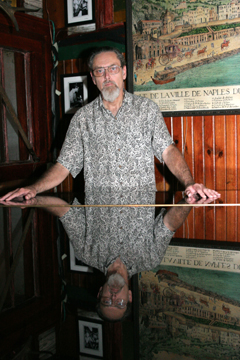 Sunday nights at Lola’s just west of downtown, a solid band of players revisits classic jazz tunes, reinventing them every time and inviting guest musicians to join in the re-creation. At Lola’s, everything goes. Everyone is welcome. Even if the average listener doesn’t understand jazz music, she can appreciate it. There is this funny thing about live jazz performances: No one knows what to expect. Jazz relies on improvisation, so no two nights will ever be the same. Drummer Dave Karnes and his compatriots take over the stage. They let loose. They let the music happen. They have been doing the same thing for over a decade every Sunday to consistently enthusiastic audiences. The Lola’s jams are a direct descendant of what went down on Evans Avenue on those Sundays 30 and 40 years ago. “It’s a cool hang,” Karnes said. “You wear what you want and the drinks are cheap. It’s gritty. I would associate it with Fort Worth jazz.”
Sunday nights at Lola’s just west of downtown, a solid band of players revisits classic jazz tunes, reinventing them every time and inviting guest musicians to join in the re-creation. At Lola’s, everything goes. Everyone is welcome. Even if the average listener doesn’t understand jazz music, she can appreciate it. There is this funny thing about live jazz performances: No one knows what to expect. Jazz relies on improvisation, so no two nights will ever be the same. Drummer Dave Karnes and his compatriots take over the stage. They let loose. They let the music happen. They have been doing the same thing for over a decade every Sunday to consistently enthusiastic audiences. The Lola’s jams are a direct descendant of what went down on Evans Avenue on those Sundays 30 and 40 years ago. “It’s a cool hang,” Karnes said. “You wear what you want and the drinks are cheap. It’s gritty. I would associate it with Fort Worth jazz.”
His denim-clad audience would likely agree. When the old Black Dog Tavern lived on Throckmorton Street downtown, artists of all varieties would show up to witness the power of the voodoo rooted music to transform a night. When the tavern moved to the Cultural District, everyone followed. When the new Black Dog barked its last, Karnes and crew relocated to Lola’s, which is a rock joint the other nights of the week. Jazz fits in just fine. Karnes embarks on a drum solo, concluding in a place where the diminutive anachronism Oklin Bloodworth – a living bit of local jazz history – picks it up. Bloodworth sings a historical tune with his distinctive voice. “Jazz has always been on and off,” said Bloodworth, who moved to town in 1941. “It all depends on where you are and who cares. The youngsters now really seem to like it.” The casual crowd halfway listens. Most might not comprehend the intricacies of the music, but they show up anyway. “For the last year, the Lola’s jam has been full,” Karnes said. “Jazz is doing better now. It’s a different thing going to see live jazz. We make people want to go out and have an experience.”
Karnes and his crew, which besides Bloodworth includes guitarist Paul Metzger, bassist Drew Phelps, vibraphone player Joey Carter, and saxophonist Rodney Bowens, play on Sundays for a reason. All working musicians, they spend the week hustling and playing other gigs to pay the bills. Sunday is the night when the spirit of the music reigns. “You’re completely exposed when you play every week,” Karnes said. “It’s an honor when people show up. We’re not fooling anybody, so they start listening to the vibe of the thing. We want to turn people on to jazz. They have to go see it. Then they get it.” The Sunday cats earn only a little bit of money for their night’s work. But the jazz evolution in town is real, in the way that jazz embodies the stories of modern American history and the cities in which it somehow fits. By all accounts, Fort Worth is one of those places.
Fort Worth’s readiness to embrace a bigger jazz scene led Ricki Derek here. The big-band, Sinatra-style singer from Dallas envisioned Sundance Square as the optimal location for North Texas’ only full-time, traditional jazz club. A born entertainer, Derek possessed a “sizzling” vision for his own digs. “Fort Worth could handle it better than any city around,” Derek said about his new and immaculate Scat Jazz Lounge. In addition to Sundance Square’s accessibility and security, Derek said, he was impressed by the support the arts receive in this Western part of the Metroplex. Fort Worth is a casual place where pretensions are minimized. Cowtown’s pace is slower and there’s an appreciation of the simple things. Maybe that’s why Tarrant County residents make good jazz listeners: They can stop and pay attention long enough to appreciate the moments in the music.
Derek, who owns the Scat with partners Cary Ray and Neil Connell, books the club’s entertainment schedule. His preference is straight-ahead, almost academically clean jazz. Nothing progressive. Nothing too “out there” for the suit-and-tie crowd. “I wanted a place where adults can come to listen to a band, have conversation and a good drink,” he said. Derek and his partners expect to draw a non-traditional Fort Worth bar crowd into their classy new joint. “I believe there are enough people, enough smart adults.” Derek said. “It’s a big dice roll. It’s a little overwhelming. People seem to dig the place, and I’m glad we’ve come here.” Even though all the partners live in Dallas, they agreed that downtown Fort Worth provided the only real opportunity in the area to open a viable jazz club. Ray and Connell are also involved in the ownership of the Sundance seafood joint Daddy Jack’s. “It’s been a positive experience being accepted in Fort Worth. Plus, we’d developed a relationship with the people from Sundance.” Ray said.
Ray and Connell also own the Cavern, a Dallas rock venue, so when Sundance came looking for the right people to run a bar, the two had a proven track record. When Sundance’s leasing director showed the men the basement of the Woolworth building, Ray visualized a space for live music. “I saw a dark, cozy place to come after dinner, after the Bass Hall,” Ray remembered. “It would be cool, comfortable, and soft on the senses.” All systems go – back in 2003, that is. Red tape and construction logistics delayed the opening until just three months ago. When the Scat finally opened its doors in December 2007, the 140-person capacity room was ready to assume a name and a reputation as North Texas’ only legitimate full-time jazz destination. Considering the partners inked a 10-year lease, they are making a serious commitment to jazz in Fort Worth. “We don’t want to be gimmicky,” Ray said. “Our motto is quality entertainment or no entertainment … . The challenge is to make it work as a business.”
Derek is the musician among the partners, but he’s also one of the entrepreneurs. “It’s a double-edged sword, mixing art and commerce,” he said. Although he wants nothing less than the very best players to grace his blue-and-red-lit stage, entertainment potential has to take top billing over the musicians’ freedom to go where the spirit takes them. He likes to quote jazz trumpeter Dizzy Gillespie, who said about entertaining: “It’s about the show, right or wrong.” Derek’s own band has taken the stage a handful of times since the Scat’s opening in December. The Rat Pack-style singer cracks jokes about intoxication between his renditions of show tunes and jazz favorites. Always dressed immaculately to create an air of sophistication, he employs some of the area’s top jazz musicians to back his voice. Whether with a quintet or a 15-piece big band, Derek shows up to entertain, to get people dancing. He feels like he’s hitting the market at the right time. “Jazz goes away, then it comes back,” he said. “Jazz is getting more attention. It’s getting its own institution. People are shaking it up.”
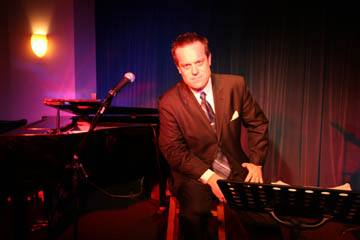 Adonis Rose came to Fort Worth to shake things up a little, too. The jazz drummer from New Orleans, whose resume runs from Public Enemy to Harry Connick, Jr., didn’t exactly intend to settle here. When Hurricane Katrina hit New Orleans, Rose and his wife couldn’t find a hotel room any closer than Irving. He had an offer to join Connick on tour, but Rose decided to stay and grow roots in Fort Worth. He had an inkling that Cowtown could offer the resources and ears necessary to make it the jazz capital of the Southwest.
Adonis Rose came to Fort Worth to shake things up a little, too. The jazz drummer from New Orleans, whose resume runs from Public Enemy to Harry Connick, Jr., didn’t exactly intend to settle here. When Hurricane Katrina hit New Orleans, Rose and his wife couldn’t find a hotel room any closer than Irving. He had an offer to join Connick on tour, but Rose decided to stay and grow roots in Fort Worth. He had an inkling that Cowtown could offer the resources and ears necessary to make it the jazz capital of the Southwest.
“All the pieces of a puzzle are coming into place,” said Rose. “I would like to see downtown become a new entertainment area. The Scat in particular “will be a catalyst for more people to have jazz in their plans.” When Rose decided to stay in North Texas, he immediately began to forge connections. In addition to partnering with Tim Ishii to establish a jazz education department at UT-A, Rose made friends with the people at McDavid Studios at Bass Hall. He founded the Fort Worth Jazz Orchestra, which has been playing monthly in the wood-floored room adjacent to Bass Hall. Although Standridge brought big-band style to town 20 years prior, Rose kicked the marketing campaign into the stratosphere.
So far, so good, according to Rose. “My audiences here are great,” Rose said. “They’re educated, and they really support the music … . I see Fort Worth coming together in the next five years. It will be a different town.” Rose, as much a businessman as a musician, is drawing on his knowledge of New Orleans’ jazz infrastructure to help propel Fort Worth to the next level. “In a city like New Orleans, the number one attraction is entertainment,” he said. “The music and food bring people there. It helps to have everything in one area.” New Orleanians alone aren’t enough to support a vibrant musical community – they need tourists to fill in with their dollars and warm bodies. And that should be part of the equation in Fort Worth, too, Rose said. With several new hotels scheduled to open here in 2008, he envisions many thousands more visitors each year wandering in to McDavid Studios and the Scat Lounge. They just need to be aware of the jazz presence in Fort Worth, he said, when what many expect to find is pure Cowboyville.
David DuBois, president and CEO of the Fort Worth Convention and Visitor’s Bureau, agreed. “When people come to Fort Worth, they don’t think about jazz,” he said. “We want people to come to appreciate more than country music.” DuBois and his bureau are working aggressively to establish Fort Worth as an international tourist destination with a rich variety of cultural offerings in addition to Western heritage. “Music and jazz are part of the product,” Dubois explained. “On a Friday or Saturday night in Sundance square, a visitor can stand in a parking lot and hear all kinds of outdoor music.” Jazz lends a legitimacy to a true cultural center, in his eyes. With an estimated ten million out-of-town visitors passing through in 2008 alone and downtown residential development booming, businesses are scrambling for pieces of the profits. If the Omni and Sheraton hotels open downtown this year as scheduled, even more potential jazz listeners will arrive in the vicinity. Ruth’s Chris Steakhouse, The Vault, and Shula’s 347 restaurants are all expected to open this year, adding about a thousand restaurant seats in the area – and, potentially, that many more folks looking to for after-dinner entertainment within walking distance. The Scat in particular is “a hidden jewel,” DuBois said. “It will grow as word of mouth spreads.”
DuBois and Rose are already working together to serve as spokesmen for the jazz movement in town. Rose recently traveled with DuBois to Chicago for a meeting of convention planners. “We have a reason to showcase Adonis and the Fort Worth Jazz Orchestra,” DuBois said. “We want to show the great variety of offerings here.” For jazz to grow stronger in Fort Worth, Rose said, “the entire arts community has to come together to build a presence,” and he’s willing to work with whomever it takes. He plans on joining forces with the Scat Lounge to help bring high-quality, national acts into that club. The Scat can claim a place in the ranks of world-class jazz clubs like New York City’s The Village Vanguard and the Blue Note, he said. It’s “really hip. I feel like I’m getting a slice of New York.” Rose never doubted the musical quality of the players already in Fort Worth, but he wants to change the rules of how people play and earn money here. Jazz musicians, in his opinion, deserve a bigger spotlight and more income. “Other musicians don’t think like I do,” he claimed. “My perspective is broad. I dream big.”
In Fort Worth’s church of jazz, the religion lies in breaking the rules. Improvisation is at the heart of the kind of jazz favored by Ornette Coleman and the other Terrell musos – the kind of music still happening at Lola’s on Sunday nights. At Sardines, Kahsen normally leans more toward dinnertime entertainment, but he’s been able to experiment with all types of jazz. The Paris, Texas, native recently started hosting avant-garde nights periodically. Avant-garde jazz relies on total improvisation and a disregard for standard rules of playing music. It gives the “anything goes” idea a whole new expression. His musical anarchy keeps Coleman’s free-jazz inventions pertinent in today’s Fort Worth. Then there’s straight-ahead jazz, the kind you go to the McDavid Studio or the Scat to hear. Kahsen has played the Scat once thus far, and he hopes the venue will thrive. The more the merrier for the jazz community, he believes. Diversity and conversation are what fueled the art in the first place. He has seen enough to keep his expectations low, however. “I don’t think audiences are ready to support straight-ahead jazz,” he said.
The reality is that many musicians play all over the jazz map. Joey Carter started playing music in West Fort Worth when he was nine. Now in his early 40s, he’s living proof that it’s possible to earn a living playing jazz music in Fort Worth – if you’re willing to do what it takes. The hardest working guy around sits on the piano bench at Sardines the one night a week Kahsen doesn’t use it. He composes on the ivories at the Scat during happy hour, and lends his skills on the vibraphone at Lola’s Sunday night jam. In all, he typically plays six to ten gigs a week – in addition to his job as a music instructor at TCU.
“I’m not happy working that hard,” he said, “but it’s difficult to make enough money.” He’s also a young father without the luxury of being picky about his jobs. “It would be nice to make more money, but I really like playing. There is an addictive quality to it,” he said. “Playing piano is the most liberating thing I do all week. … It’s very in-the-moment, Zen stuff.” He’s lucky, he knows, to be able to maintain a lifestyle where playing so much music is even possible. In today’s over-saturated music market, “a lot of people don’t go out to see live music,” he said. “They don’t pay attention. They don’t need to get out, they have iPods.”
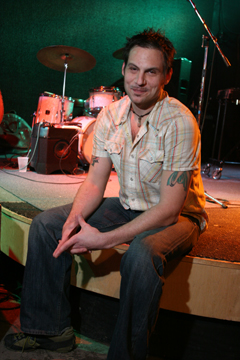 But something good is happening here, he said, even if financial rewards still aren’t luxurious. Support for local jazz “is getting consistently better,” Carter said. And he believes it’s particularly strong in Fort Worth. His hometown offers more in terms of musical sustainability than its big neighbor to the East for one reason, he said: “The ‘where the West begins’ thing is true,” Carter said. “There’s a different mindset here. People are more laid-back.” All of the above translate into a listener-friendly environment. “At least listeners here appreciate it,” he said. Carter’s Sunday bandmate Karnes agrees. “Jazz is doing better now,” he said. “My theory is that it’s thanks to the internet and people’s ability to write and record themselves.” With an entire population’s musical history available for free with the touch of a button, any musical renaissance has to be based on live performances, he said, and jazz is as live as it gets, when an evening can mean hours of improvisations that never get recorded and can’t be replicated.. “We want to make jazz something people want to do,” he said. “It’s an experience.”
But something good is happening here, he said, even if financial rewards still aren’t luxurious. Support for local jazz “is getting consistently better,” Carter said. And he believes it’s particularly strong in Fort Worth. His hometown offers more in terms of musical sustainability than its big neighbor to the East for one reason, he said: “The ‘where the West begins’ thing is true,” Carter said. “There’s a different mindset here. People are more laid-back.” All of the above translate into a listener-friendly environment. “At least listeners here appreciate it,” he said. Carter’s Sunday bandmate Karnes agrees. “Jazz is doing better now,” he said. “My theory is that it’s thanks to the internet and people’s ability to write and record themselves.” With an entire population’s musical history available for free with the touch of a button, any musical renaissance has to be based on live performances, he said, and jazz is as live as it gets, when an evening can mean hours of improvisations that never get recorded and can’t be replicated.. “We want to make jazz something people want to do,” he said. “It’s an experience.”
Every player offers a unique insight into the infinite possibilities of jazz expression. “Jazz songs are classic subjects,” Karnes explained. “The interpretations of the tunes are endless – it never runs dry. It’s always about what happened today. It’s a never-ending dialogue.” Oklin Bloodworth thinks the freedom inherent in jazz structures is very liberating to the listener. He’s thankful to have lived in a town where someone always refused to let jazz die. “It never stopped here,” he said. “Someone always kept it going.” Jazz’ central feeling – a free spirit – is as important today as ever, in his eyes. He’d like to see even more of it, “So people wouldn’t have to listen to sad, sad songs and think about all their misery.”
For longtime Fort Worth jazz lovers, this kind of discussion has to be, well, music to the ears. What – a menu of jazz styles to choose from? Denim or diamonds, improv or big band? What luxury. The folks who rejoiced when Thai food pioneers crossed the Tarrant County line have nothing on what jazz fans are probably feeling now. “It’s starting to get competitive around here,” Karnes said – and a lot of that is due to the new blood in town. “The Scat is a venue for people from outside the area to play and promote themselves,” he said. Building a strong scene now will translate in a brighter future. Youngsters get most of their jazz education by actually stepping out to listen to seasoned players. Adonis Rose is starting a summer jazz camp here, and aficionados like Kahsen are expressing interest in becoming more education-oriented. The Fort Worth Public Library has also started a jazz archives, where Tom Kellam collects interviews and memorabilia from local jazz history.
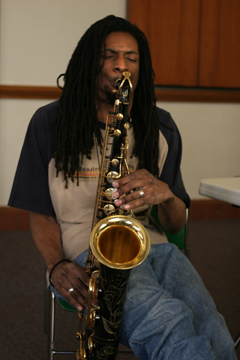 Quamon Fowler, who grew up in Fort Worth, met Adonis Rose while Quamon was a student at Louisiana’s Southern University. He’s thrilled that the New Orleanian has moved to Fowler’s own turf. “It changed my whole perception of home,” he said. “He hit the ground running, and that’s what we needed to stir stuff up.” Fowler, who plays in Rose’s Fort Worth Jazz Orchestra, sees a renewed optimism in his hometown. “In the last year, everything has changed,” he said. “It’s giving the younger musicians a reason to be motivated about playing. There is hope that you can strive to be a player.” Marjorie Crenshaw disagrees about Rose’s importance. She just wants people to follow the rules: Club owners ought to focus on jazz rather than mixing up various genres. Musicians ought to be finicky about the union standards she and others worked hard to set. And people like Rose, who come to a place where so many jazzbos have struggled for so long and immediately get high-profile gigs, destabilize her status quo.
Quamon Fowler, who grew up in Fort Worth, met Adonis Rose while Quamon was a student at Louisiana’s Southern University. He’s thrilled that the New Orleanian has moved to Fowler’s own turf. “It changed my whole perception of home,” he said. “He hit the ground running, and that’s what we needed to stir stuff up.” Fowler, who plays in Rose’s Fort Worth Jazz Orchestra, sees a renewed optimism in his hometown. “In the last year, everything has changed,” he said. “It’s giving the younger musicians a reason to be motivated about playing. There is hope that you can strive to be a player.” Marjorie Crenshaw disagrees about Rose’s importance. She just wants people to follow the rules: Club owners ought to focus on jazz rather than mixing up various genres. Musicians ought to be finicky about the union standards she and others worked hard to set. And people like Rose, who come to a place where so many jazzbos have struggled for so long and immediately get high-profile gigs, destabilize her status quo.
“When a musician comes to town, you get acquainted with other musicians. Then you go to the union office and join. Adonis didn’t do it right,” she said. All that is part of the mix. The musical back-and-forth of the genre isn’t all sweetness and agreement. The changes that are coming won’t please everyone. But the ongoing dialogue that is jazz continues here, with more voices every day joining in the discussion. Unlike rock or any other kind of music, jazz requires different voices bouncing off each other – shark-like, it has to keep moving to stay alive. It tells the history of American culture by blending cultures and musical influences, then constantly adapting to the changes.
Like jazz, Fort Worth is a culture in flux these days, as the demographics and the city’s feel changes, with more people from more places moving here, particularly to the increasingly urban neighborhoods in and around downtown. The city needs some great blender of people, some way to develop new definitions of Fort Worth. Maybe jazz can do as much for this city as Cowtown can for jazz.






